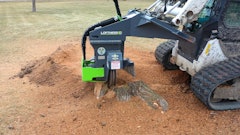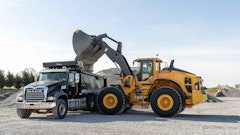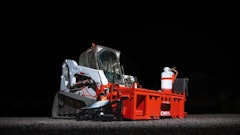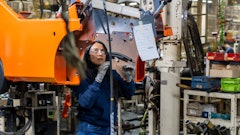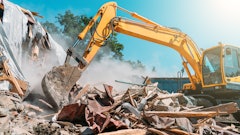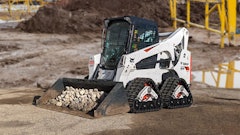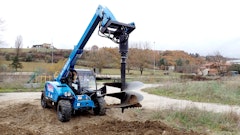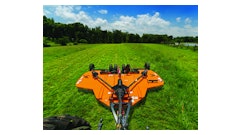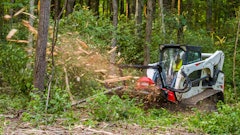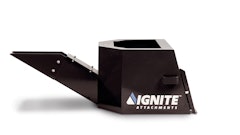
Despite the severity of the conditions and applications they encounter, concrete crusher and mobile shear attachments are capable of providing hundreds of hours of useful operation — provided they are properly used and maintained.
“Proper operating techniques must be closely adhered to, as outlined in the manufacturer’s operating guide, to eliminate costly mistakes that will damage the attachment or supporting carrier,” says Kevin Loomis, business line manager for Construction Tools, Atlas Copco.
This requires an understanding of proper attachment operation. “Improper application of the attachment and incorrect choice of material will cause damage to wear items, like cutting surfaces, teeth and other components,” says Greg Smith, marketing communications manager, Allied Construction Products. “It also decreases the carrier life and causes damage to carrier components.”
Operating Practices to Avoid
There are a number of common misapplications that can result in premature wear and tear on crusher or shear components.
“With both rotating shears and concrete processors, a very common operator mistake is to use the rotator as a prying or twisting tool,” says Clay Sederberg, engineering manager, Stanley Hydraulic Tools. “The rotator is designed for positioning, saving time tracking the excavator and also performing difficult vertical processing.”
“The rotation group in a shear is designed to position it for the cut, not to aid in cutting by twisting or prying,” agrees Tim Alseth, technical services manager, Genesis Attachments. “Twisting and pulling is really hard on the rotation group.”
The rotation function of the attachment is designed to withstand the breakout forces (stick and bucket cylinder manipulation) of the excavator, but not the drawbar pull (tractive) effort, Sederberg explains. “Using the excavator tractive force is a common misuse in demolition applications, where the attachment clamps down on a structure and then back tracks with the force of the excavator,” he points out.
This can cause stress and potential damage to both attachment and carrier components. “When you’re pulling and twisting, or grabbing heavy objects on one end vs. grabbing in the middle, what will happen is it will back drive the motor shaft through the gearbox, which has a tendency to break things,” says Alseth. “Motor housings and gearbox covers, etc., will typically fail from doing things like that.”
Another practice to avoid is rubbing a mobile shear attachment on the ground during cutting operations. This can accelerate wear on the chin plate and the front of the upper jaws. “[The dirt] acts like sandpaper. With the amount of weight that you’re putting behind it with the excavator, it just erodes the front of the attachment away,” says Alseth. It can also result in dirt ingress between the blades, accelerating wear of these components.
Alseth further advises against reaching into and attempting to cut through a material pile rather than cutting individual pieces. “What that does is drag material into the lower jaw between the guide blades before the upper comes in, and it jams the shear up,” he states.
Attempting to break rather than cut material is another common misapplication of shears, particularly when trying to process material that is harder than the blades, such as hardened steel. “This has a tendency to chunk the blades away and cause premature wear,” says Alseth. “Also, the decompression spikes damage hydraulic system components both on the shear and the excavator.”
“The excavator builds pressure which is abruptly released as the material breaks, causing a pressure ‘shock’ to the entire hydraulic system (causing O-rings to fail and premature wear on all seals) to both the shear and the excavator,” Sederberg elaborates. “Continued shock loading can cause structural issues such as cracking in the jaws of the attachment.”
Size to the Task and the Carrier
To further minimize the risk of damage, it’s important to use the appropriate attachment and configuration for the application, particularly when processing oversized materials.
“The Concrete Cracker is designed to break large concrete away from the structure, and a Concrete Pulverizer is designed for crushing and separating rebar,” Sederberg notes of LaBounty crushing attachments. “Using the tools and jaws in the proper applications will provide longer life expectancies and will therefore give more value for the investment.”
He notes that “appetite charts” are generally available from the OEM for initial sizing of the attachment to the material. “As a general rule, the attachment should be cutting or breaking the material in single open-close cycles,” he states. “Continual clamping or chewing on material should be avoided when possible.”
Sizing the attachment to the carrier is also important, especially given that many applications require working at heights. This makes it especially critical to follow OEM recommendations.
“As with any attachment, proper sizing to the host carrier and application is crucial to the safety and productive life of the crusher or shear,” says Loomis. “Undersizing the attachment to the carrier may expose the attachment to bending forces and structural damage due to forces well above the integrity of the attachment’s design. Oversizing the attachment can lead to structural damage to the host carrier or create unsafe tipping conditions while performing overhead work.”
“Most Concrete Crackers are engineered to a specific excavator weight,” says Sederberg. “The excavator cylinders play a key role in the design, so if you try to put a Concrete Cracker on an excavator that’s too large, the more powerful cylinder on the excavator could destroy the [attachment].”
An oversized carrier will place undue stress on the rotator, which can have disastrous results. “Just last month, we had a customer using a 90,000-lb. excavator attach a UP25 with Concrete Cracker jaw, which comes recommended for a 55,000-lb. machine. The power and weight of the excavator destroyed the rotation unit,” says Sederberg.
More typical repercussions of undersizing an attachment include diminished performance and increased component wear and tear. “If the attachment is too small, you may not be able to process the material based on size and type,” says Smith. “You may experience a need for more frequent maintenance intervals and increased repairs to reduce premature failure of structural and major components that may not be covered by the manufacturers’ warranty.”
Conversely, an excavator that is too small for the attachment will not have sufficient power to perform to its designed capability, says Sederberg. “In addition, the weight of the attachment could be too much for the cylinders and cause excavator cylinder failure or even tip over the machine,” he points out.
“Using too large an attachment for the carrier can damage carrier brackets, boom and hydraulic components,” says Smith. “In addition, the hydraulic system may not be adequate to achieve the required flow and pressures of the shear or processor, which results in poor performance and increased cycle times.”
Avoid the High Costs of Neglect
One of the biggest factors in determining the longevity and performance of a crusher or mobile shear attachment is how it’s maintained.
“When daily inspections and maintenance routines are not performed, the overall service life and productivity of a crusher/shear can be greatly diminished,” says Loomis. “Excessive clearance dimensions between cutting surfaces can facilitate material jamming between them in lieu of a clean cut. Allowing wear bushings to exceed their useful dimensions at pivot locations can cause exaggerated angles of the moveable jaws, which will lead to additional stresses on pins and structural components.”
“The overall lack of maintenance (blade gaps, greasing, etc.) causes deflection of the upper jaw and causes it to twist,” says Alseth. “It puts undue stress on the pins and bushings in the pivot group, as well as the cylinder and the upper and lower jaws. You get excessive wear to the blades and that creates an issue with jamming and also cracking of the chin plate. It will also cause tie-rods and end cap bolts to break.
“The problem is it’s typically not noticeable on a short-term basis,” he continues. “It induces fatigue into the structures and it ultimately shortens the overall life of the attachment.”
It could also shorten the life of the carrier if left unattended long term. Side loading resulting from twisting can prematurely wear out the wear bands inside the cylinder. “Once they wear out, you get metal to metal contact and the piston starts digging into the barrel,” says Alseth.
The resulting metal shavings can eventually work their way into the carrier’s hydraulic system. “The big-dollar cost is when you fill an excavator system full of trash. A lot of times, it will take out the pumps and the main valve,” says Alseth. “A typical decontamination of an excavator is about $75,000. Then you have to buy a shear cylinder on top of it, which can be anywhere from $30,000 to $70,000. And the amount of downtime it takes to clean this all up is horrendous.”
Performing routine inspection and maintenance, based on manufacturer recommendations, can save significant cost and extend attachment life. “It’s all dollars and cents,” says Alseth. “If you’re doing maintenance a little bit all the time, the shear is going to go a long, long time. If you’re not maintaining it, you’re not spending the money on the blades and the maintenance up front, but you’re going to ultimately end up buying another shear before long. So it’s pay me now or pay me later.”










